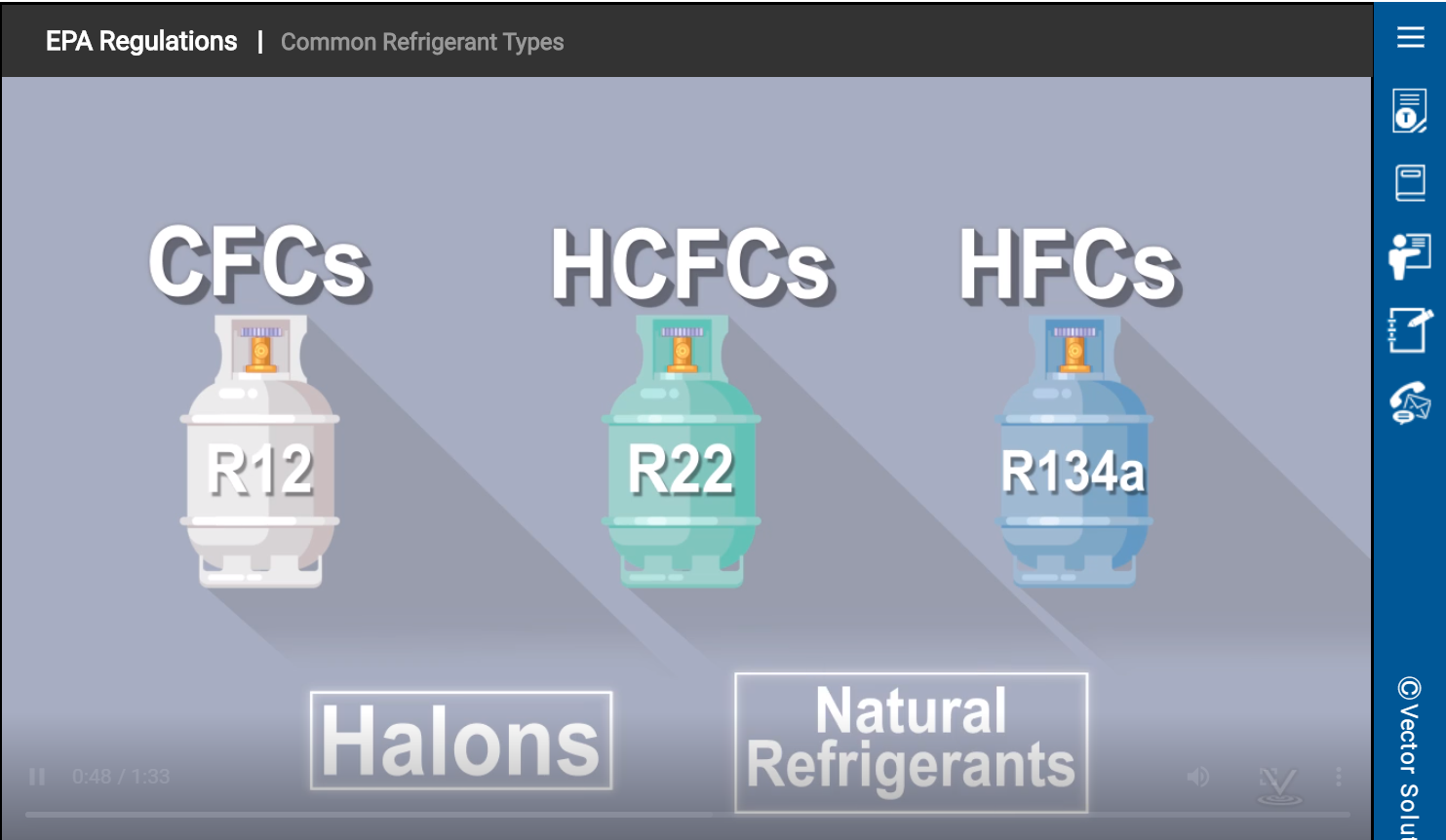October 15, 2024 6 min read

Enhancing Refrigerant Management: Aligning with the AIM Act
Industry:
Solution:

Refrigerant management has become a critical focus of health and safety efforts in the workplace, especially considering the American Innovation and Manufacturing (AIM) Act of 2020. The AIM Act mandates a significant phasedown of hydrofluorocarbons (HFCs), widely used in cooling systems, since they contribute significantly to the negative effects of climate change. As industries prepare for the AIM Act HFC phasedown, effective refrigerant management is essential for meeting regulatory compliance, reducing environmental impact, and improving operational efficiency.
Refrigerant Management Course
This interactive online course covers how to execute a refrigerant management program to be compliant with AHJ requirements, identifies EPA Regulations, and describe record keeping requirements.
View Course
What is the AIM Act?
The AIM Act, signed into law in December 2020, directs the Environmental Protection Agency (EPA) to oversee a phased reduction of HFC production and use by 85% over the next 15 years.
The AIM Act affects a variety of industries, including:
- Manufacturing: Essential for maintaining efficient and compliant refrigeration systems.
- Food and Beverage Manufacturing: Critical for handling refrigerants in food processing and preservation.
- Chemical Processing: Necessary for managing refrigerants used in chemical reactions and cooling.
- Property Management: Facilities management and maintenance teams must embrace alternative refrigerants with lower GWPs.

Key Factors Impacting Refrigerant Management
Significant components of the AIM Act HFC phasedown include:
- HFC Phasedown Schedule: The Act outlines a gradual reduction in HFC use, with benchmarks starting at a 10% reduction by 2023 and reaching an 85% reduction by 2036.
- Cap-and-Trade System: The EPA will implement a cap-and-trade system for HFC allowances, creating incentives for businesses to reduce their use and adopt alternative technologies.
- Sector-Based Restrictions: The Act empowers the EPA to set standards and restrictions tailored to specific industries to encourage the transition to next-generation refrigerants.

Why Effective Refrigerant Management Matters
Implementing robust refrigerant management in your organization is essential to maintaining a well-operating, efficient workplace. In this section, we’ll dive into some of the main areas impacted by refrigerant management efforts.
1. Environmental Impact
Data shows that a collective global phasedown of HFCs could potentially avoid up to 0.5°C of global warming by the end of the century.
HFCs are among the most harmful greenhouse gases, contributing significantly to climate change. Proper refrigerant management can drastically reduce emissions, making it a crucial component of corporate sustainability strategies.
2. Regulatory Compliance
With the AIM Act in place, businesses must ensure they are compliant with new EPA regulations. Effective refrigerant management will be key to meeting phasedown targets and avoiding penalties.
This includes:
- Adopting best practices for refrigerant recovery and reclamation
- Transitioning to lower Global Warming Potential (GWP) alternatives
3. Financial Considerations
The phasedown of HFCs will inevitably increase their market price. Businesses that delay the transition may face rising costs for refrigerants and potential compliance fines.
On the other hand, early adopters can benefit from the cap-and-trade system, potentially generating revenue through the sale of excess HFC allowances.
Best Practices for Refrigerant Management
Implementing a comprehensive refrigerant management plan is essential to meeting regulatory compliance and promoting a safe and healthy workplace environment. A successful refrigerant management plan should include:
- Management: Keep a detailed record of all refrigerants in use, their quantities, and locations.
- Leak Detection and Repair: Regularly inspect equipment for leaks and perform timely repairs to minimize emissions.
- Proper Disposal: Ensure that refrigerants are recovered and disposed of in accordance with EPA guidelines to prevent illegal venting and reduce environmental harm.
It’s important to ensure that your workforce is well-informed of the risks and opportunities of the AIM Act HFC phasedown. Proper online training for refrigerant management will help your employees:
- Describe how to execute a refrigerant management program to be compliant with Authority Having Jurisdiction (AHJ) requirements
- Identify EPA regulations
- Describe record keeping requirements
Transition to Low-GWP Alternatives
Exploring alternative refrigerants with lower GWP values is essential to enhancing the health and safety of your workplace and your regulatory compliance.
While transitioning to new refrigerants may require equipment upgrades, it is a crucial step toward long-term compliance and sustainability. Make sure to assess the costs and benefits of available alternatives and plan your transitions accordingly.
Preparing for the Future of Refrigerant Management
It’s essential that your organization is prepared for the future of refrigerant management and the AIM Act HFC phasedown. In the following section we’ll explore some ways you can best align with new regulations and keep your company competitive.
Participate in EPA Rulemaking
Organizations should actively monitor and participate in the EPA’s rulemaking process, which will shape the future of refrigerant management in the U.S. This may look like:
- Engaging with policymakers
- Shaping regulations
- Balancing environmental goals with business realities
Invest in Refrigerant Management Training
Effective refrigerant management requires a knowledgeable workforce. Investing in maintenance skills training comply with emerging regulations. This training should be targeted to roles like:
- Refrigeration Technicians
- Refrigeration Engineers
- HVAC/R Engineers
- Refrigeration Installers
- Field Service Technicians
A Training Plan Template for Facilities Maintenance Techs
Take the guesswork out of designing your training program with pre-selected online courses for seven different FM roles
Download Template
Plan for Long-Term Sustainability
The phasedown of HFCs is just one part of a broader trend toward more sustainable business practices.
Companies should view this as an opportunity to reevaluate their environmental impact and invest in technologies and practices that support long-term sustainability goals.
How Vector Solutions Helps Organizations with Refrigerant Management
The AIM Act marks a pivotal moment for refrigerant management, introducing both challenges and opportunities for industries. By developing and implementing a robust refrigerant management program, engaging in the regulatory process, and transitioning to more sustainable alternatives, your organization can navigate these changes effectively.
Vector Solutions is committed to supporting companies through this transition. Our online refrigerant management online training courses are equipped to help you navigate the complexities of the AIM Act, develop a compliance strategy, and implement effective refrigerant management practices.
Request a demo and learn more.








